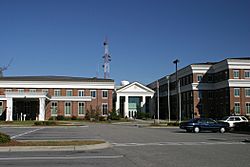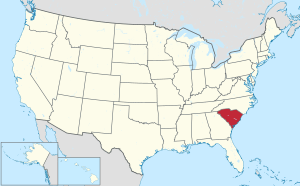Horry County, South Carolina facts for kids
Quick facts for kids
Horry County
|
|
|---|---|
|
County
|
|
| County of Horry | |

Horry County Government and Justice Center
|
|

Location within the U.S. state of South Carolina
|
|
 South Carolina's location within the U.S. |
|
| Country | |
| State | |
| Founded | 1801 |
| Named for | Peter Horry |
| Seat | Conway |
| Largest city | Myrtle Beach |
| Area | |
| • Total | 1,255 sq mi (3,250 km2) |
| • Land | 1,134 sq mi (2,940 km2) |
| • Water | 121 sq mi (310 km2) 9.6%% |
| Population
(2010)
|
|
| • Total | 289,650 |
| • Density | 230.80/sq mi (89.11/km2) |
| Time zone | UTC−5 (Eastern) |
| • Summer (DST) | UTC−4 (EDT) |
| ZIP Codes |
29511, 29526, 29527, 29527, 29528, 29544, 29545,29566, 29567, 29568, 29569, 29572, 29575, 29576. 29577, 29578, 29579, 29581, 29582, 29587, 29588, 29597, 29598
|
| Area code | 843 |
| Congressional district | 7th |
Horry County ( ORR-ee) is the easternmost county in the U.S. state of South Carolina. As of the 2010 census, its population was 289,650, making it the fourth-most populous county in South Carolina. The county seat is Conway.
Horry County is the central county in the Myrtle Beach-Conway-North Myrtle Beach, SC-NC Metropolitan Statistical Area. It is in the Pee Dee region of South Carolina, about 90 miles north of Charleston, South Carolina and about 130 miles east of the state capital Columbia.
Contents
History
Horry County (pronounced O'Ree) was incorporated in 1801. At that time the county had an estimated population of 550. It was completely surrounded by water, which forced the inhabitants to survive virtually without any assistance from the "outside world". This caused the county residents to become an extremely independent populace, and they named their county "The Independent Republic of Horry". The county was named after, and in honor of, Revolutionary War hero, Peter Horry who was born in South Carolina sometime around 1743. Horry started his military career in 1775 as one of 20 captains, elected by the Provincial Congress of South Carolina, to serve the 1st and 2nd Regiments. In 1790 he was assigned to the South Carolina militia under Brigadier General Francis “Swamp Fox” Marion
On October 29, 2012, the county paid homage to the man for whom the county is named by unveiling a bronze sculpture of Peter Horry inside the Horry County Government and Justice Center. The sculpture was designed by Lubbock, Texas artist Garland Weeks, and Coastal Monument of Conway, South Carolina designed the stone base. Located on the base of the sculpture are the names of the 1801 commissioners on one side and the names of 2011 Horry County Council members on the other side a brief bio of Peter Horry on the front. It cost slightly more than $16,200 for both the bust/sculpture and the stone base.
Geography
According to the U.S. Census Bureau, the county has a total area of 1,255 square miles (3,250 km2), of which 1,134 square miles (2,940 km2) is land and 121 square miles (310 km2) (9.6%) is water. It is the largest county by area in South Carolina. The highest point in the county is 124 ft. above sea level.
Horry County is located in the northeastern corner of South Carolina. It is a diverse land made up of rivers, beaches, forest and swamps. Horry County is bordered by the Atlantic Ocean to the east, the Little Pee Dee River and Drowning Creek (also known as the Lumber River) on Horry's western side, and North Carolina to the north. Waccamaw River, approximately 140 miles (225 km) long, runs through southeastern North Carolina and eastern South Carolina into Horry County. The river runs through the coastal plain, along the eastern border between the two states, and into the Atlantic Ocean.
Adjacent counties
- Columbus County, North Carolina - northeast
- Brunswick County, North Carolina - east
- Robeson County, North Carolina - northwest
- Georgetown County - southwest
- Marion County - west
- Dillon County - northwest
National protected area
Demographics
| Historical population | |||
|---|---|---|---|
| Census | Pop. | %± | |
| 1810 | 4,349 | — | |
| 1820 | 5,025 | 15.5% | |
| 1830 | 5,245 | 4.4% | |
| 1840 | 5,755 | 9.7% | |
| 1850 | 7,646 | 32.9% | |
| 1860 | 7,962 | 4.1% | |
| 1870 | 10,721 | 34.7% | |
| 1880 | 15,574 | 45.3% | |
| 1890 | 19,256 | 23.6% | |
| 1900 | 23,364 | 21.3% | |
| 1910 | 26,995 | 15.5% | |
| 1920 | 32,077 | 18.8% | |
| 1930 | 39,376 | 22.8% | |
| 1940 | 51,951 | 31.9% | |
| 1950 | 59,820 | 15.1% | |
| 1960 | 68,247 | 14.1% | |
| 1970 | 69,992 | 2.6% | |
| 1980 | 101,419 | 44.9% | |
| 1990 | 144,053 | 42.0% | |
| 2000 | 196,629 | 36.5% | |
| 2010 | 269,291 | 37.0% | |
| 2020 | 351,029 | 30.4% | |
| U.S. Decennial Census 1790-1960 1900-1990 1990-2000 2010-2019 |
|||

2020 census
| Race | Num. | Perc. |
|---|---|---|
| White (non-Hispanic) | 265,729 | 75.7% |
| Black or African American (non-Hispanic) | 39,367 | 11.21% |
| Native American | 1,174 | 0.33% |
| Asian | 4,578 | 1.3% |
| Pacific Islander | 303 | 0.09% |
| Other/Mixed | 15,574 | 4.44% |
| Hispanic or Latino | 24,304 | 6.92% |
As of the 2020 United States census, there were 351,029 people, 140,260 households, and 89,281 families residing in the county.
2010 census
As of the 2010 United States Census, 269,291 people, 112,225 households, and 72,254 families resided in the county. The population density was 237.5 inhabitants per square mile (91.7/km2). The 185,992 housing units averaged 164.0 per square mile (63.3/km2). The racial makeup of the county was 79.9% white, 13.4% black or African American, 1.0% Asian, 0.5% American Indian, 0.1% Pacific islander, 3.1% from other races, and 2.0% from two or more races. Those of Hispanic or Latino origin made up 6.2% of the population. In terms of ancestry, 15.3% were American, 13.4% were African American (which can include other ethnicities), 13.3% were Irish, 12.8% were German, 11.3% were English, and 6.1% were Italian.
Of the 112,225 households, 27.3% had children under the age of 18 living with them, 47.2% were married couples living together, 12.5% had a female householder with no husband present, 35.6% were not families, and 26.8% of all households were made up of individuals. The average household size was 2.37 and the average family size was 2.84. The median age was 41.1 years.
The median income for a household in the county was $43,142 and for a family was $51,608. Males had a median income of $37,351 versus $29,525 for females. The per capita income for the county was $24,811. About 11.6% of families and 16.1% of the population were below the poverty line, including 25.2% of those under age 18 and 7.5% of those age 65 or over.
Transportation
Airports
- Myrtle Beach International Airport (MYR)
- Grand Strand Airport - North Myrtle Beach (CRE)
- Conway-Horry County Airport (HYW)
- Twin City Airport - Loris (5J9)
- Green Sea Airport (S79)
Mass transit
- The Coast RTA bus system operates seven days a week, 364 days a year, on 15 routes throughout the Horry County/Grand Strand area, including Myrtle Beach, North Myrtle Beach, Surfside Beach, Garden City, Conway, Loris, and Aynor.
Major highways
 Future I-73
Future I-73 Future I-74
Future I-74 US 17 (BUS)
US 17 (BUS) US 76
US 76 US 378
US 378 US 501 (BUS)
US 501 (BUS) US 701
US 701 SC 9
SC 9 SC 22
SC 22 SC 31
SC 31 SC 65
SC 65 SC 90
SC 90 SC 179
SC 179 SC 319
SC 319 SC 410
SC 410 SC 544
SC 544 SC 707
SC 707 SC 905
SC 905 SC 917
SC 917
Communities
Cities
- Conway (county seat)
- Loris
- Myrtle Beach
- North Myrtle Beach
Towns
Census-designated places
- Bucksport
- Forestbrook
- Garden City
- Little River
- Red Hill
- Socastee
Unincorporated communities
- Adrian
- Allsbrook
- Baxter Forks
- Bayboro
- Brooksville
- Bucksville
- Burgess
- Carolina Forest
- Causey
- Cedar Branch
- Cherry Grove
- Chestnut Hill
- Cool Spring
- Crescent Beach
- Daisy
- Dog Bluff
- Dongola
- Duford
- Fantasy Harbour
- Floyds
- Galivants Ferry
- Glass Hill
- Green Sea
- Gurley
- Hand
- Hammond
- Hickory Grove
- Homewood
- Ingram Beach
- Jordanville
- Ketchuptown
- Klondike
- Konig
- Little Town
- Longs
- Nixonville
- Nixons Crossroads
- Ocean Drive Beach
- Pine Island
- Playcard
- Polecat Landing
- Poplar
- Red Bluff Crossroads
- Stephens Crossroads
- Shell
- Springmaid Beach
- Toddville
- Wampee
- Windy Hill Beach
Economy
In 2013, PTR Industries, a gunmaker, relocated to the Cool Springs Business Park near Aynor from Bristol, Connecticut.
Twenty-one PTR employees relocated from Bristol. The company stated that it would hire an additional 30 workers in the first quarter of 2014, with a goal of having 120 employees by 2017.
See also
 In Spanish: Condado de Horry para niños
In Spanish: Condado de Horry para niños

